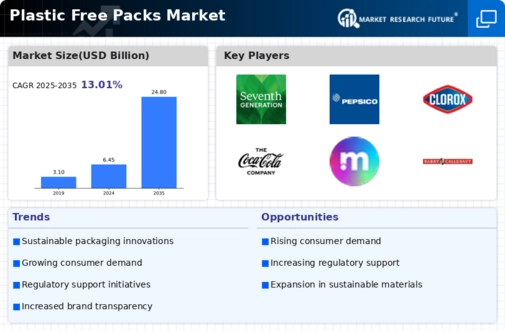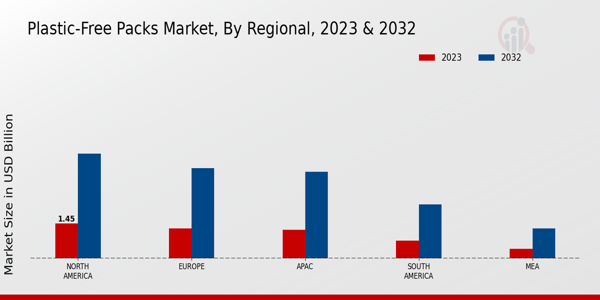Market Growth Projections
The Global Plastic Free Packs Market Industry is poised for remarkable growth, with projections indicating a market value of 6.45 USD Billion in 2024 and an anticipated increase to 24.8 USD Billion by 2035. This growth trajectory reflects a compound annual growth rate of 13.01% from 2025 to 2035, underscoring the increasing adoption of sustainable packaging solutions across various sectors. As consumers and businesses alike prioritize eco-friendly practices, the demand for plastic-free packs is expected to surge, driving innovation and investment in the industry. This upward trend highlights the potential for substantial market expansion in the coming years.
Rising Environmental Awareness
The Global Plastic Free Packs Market Industry experiences a notable surge in demand driven by increasing environmental awareness among consumers. As individuals become more conscious of the detrimental effects of plastic pollution, they actively seek alternatives that align with sustainable practices. This shift is evident in the growing preference for biodegradable and compostable packaging solutions. For instance, a significant portion of consumers now prioritizes eco-friendly products, influencing brands to adopt plastic-free packaging. This trend is projected to contribute to the market's growth, with estimates suggesting a market value of 6.45 USD Billion in 2024, reflecting a broader commitment to environmental sustainability.
Regulatory Support and Initiatives
Government regulations and initiatives aimed at reducing plastic waste play a crucial role in shaping the Global Plastic Free Packs Market Industry. Various countries are implementing stringent policies to limit single-use plastics, thereby encouraging manufacturers to explore sustainable packaging alternatives. For example, the European Union has introduced directives that mandate reductions in plastic consumption, prompting businesses to innovate in packaging design. Such regulatory frameworks not only foster a conducive environment for the adoption of plastic-free packs but also enhance market growth. This regulatory push is expected to propel the market towards a projected value of 24.8 USD Billion by 2035, indicating a robust trajectory for sustainable packaging solutions.
Innovations in Packaging Technology
Innovations in packaging technology are driving the evolution of the Global Plastic Free Packs Market Industry. Advances in materials science have led to the development of innovative alternatives to traditional plastic packaging, such as plant-based materials and recycled paper products. These innovations not only meet consumer demand for sustainable options but also enhance the functionality and durability of packaging solutions. For instance, companies are increasingly utilizing materials that are both biodegradable and cost-effective, thereby appealing to a broader audience. As these technologies continue to evolve, they are likely to play a pivotal role in shaping the future of the market, fostering a shift towards more sustainable practices.
Consumer Demand for Sustainable Products
The Global Plastic Free Packs Market Industry is significantly influenced by the rising consumer demand for sustainable products. As consumers increasingly prioritize sustainability in their purchasing decisions, brands are compelled to adapt their packaging strategies accordingly. This shift is reflected in the growing popularity of products packaged in eco-friendly materials, which are perceived as healthier and more responsible choices. Companies that embrace plastic-free packaging not only enhance their brand image but also tap into a lucrative market segment. With a projected compound annual growth rate of 13.01% from 2025 to 2035, the market is poised for substantial expansion as consumer preferences continue to evolve.
Corporate Social Responsibility Initiatives
Corporate social responsibility (CSR) initiatives are becoming increasingly integral to the Global Plastic Free Packs Market Industry. Companies are recognizing the importance of sustainability in their operational strategies and are actively engaging in practices that promote environmental stewardship. By adopting plastic-free packaging, businesses not only reduce their ecological footprint but also resonate with environmentally conscious consumers. This alignment with CSR principles enhances brand loyalty and can lead to increased market share. As more companies commit to sustainability, the demand for plastic-free packaging solutions is expected to rise, further propelling the market's growth trajectory.























Leave a Comment